air conditioning CHEVROLET HHR 2007 1.G Owners Manual
[x] Cancel search | Manufacturer: CHEVROLET, Model Year: 2007, Model line: HHR, Model: CHEVROLET HHR 2007 1.GPages: 446, PDF Size: 2.43 MB
Page 101 of 446
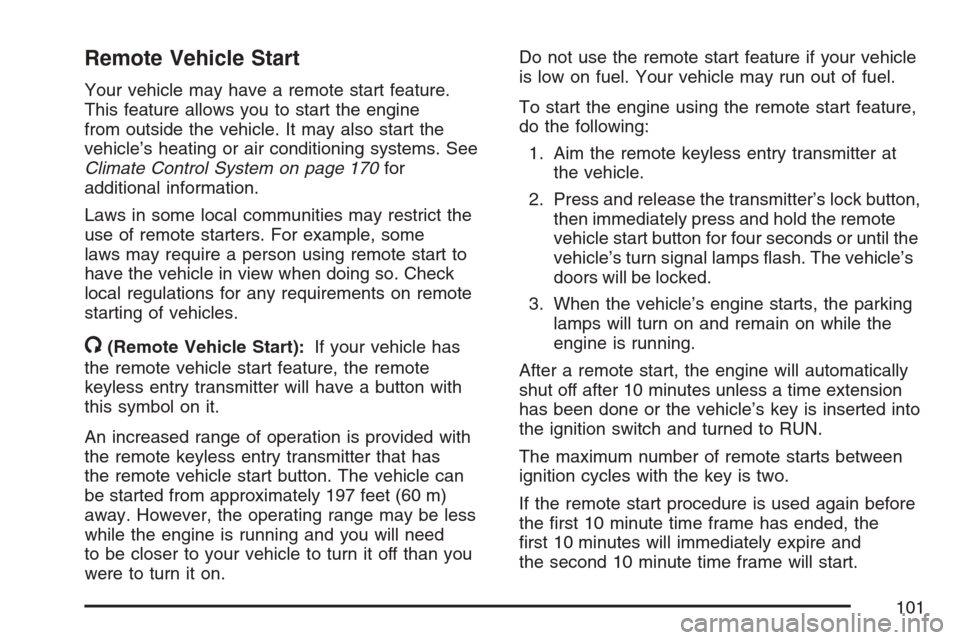
Remote Vehicle Start
Your vehicle may have a remote start feature.
This feature allows you to start the engine
from outside the vehicle. It may also start the
vehicle’s heating or air conditioning systems. See
Climate Control System on page 170for
additional information.
Laws in some local communities may restrict the
use of remote starters. For example, some
laws may require a person using remote start to
have the vehicle in view when doing so. Check
local regulations for any requirements on remote
starting of vehicles.
/(Remote Vehicle Start):If your vehicle has
the remote vehicle start feature, the remote
keyless entry transmitter will have a button with
this symbol on it.
An increased range of operation is provided with
the remote keyless entry transmitter that has
the remote vehicle start button. The vehicle can
be started from approximately 197 feet (60 m)
away. However, the operating range may be less
while the engine is running and you will need
to be closer to your vehicle to turn it off than you
were to turn it on.Do not use the remote start feature if your vehicle
is low on fuel. Your vehicle may run out of fuel.
To start the engine using the remote start feature,
do the following:
1. Aim the remote keyless entry transmitter at
the vehicle.
2. Press and release the transmitter’s lock button,
then immediately press and hold the remote
vehicle start button for four seconds or until the
vehicle’s turn signal lamps �ash. The vehicle’s
doors will be locked.
3. When the vehicle’s engine starts, the parking
lamps will turn on and remain on while the
engine is running.
After a remote start, the engine will automatically
shut off after 10 minutes unless a time extension
has been done or the vehicle’s key is inserted into
the ignition switch and turned to RUN.
The maximum number of remote starts between
ignition cycles with the key is two.
If the remote start procedure is used again before
the �rst 10 minute time frame has ended, the
�rst 10 minutes will immediately expire and
the second 10 minute time frame will start.
101
Page 171 of 446
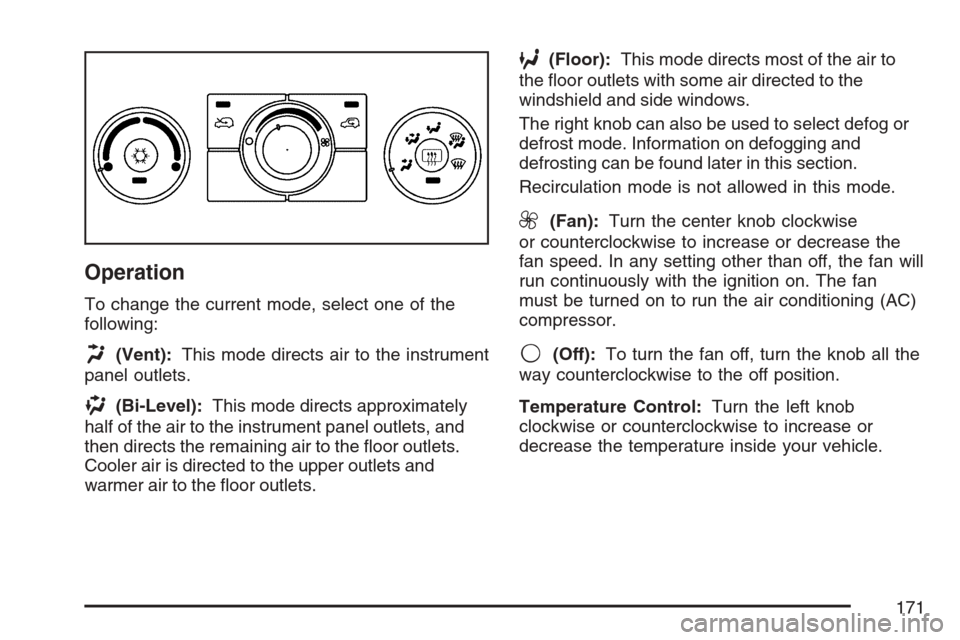
Operation
To change the current mode, select one of the
following:
H(Vent):This mode directs air to the instrument
panel outlets.
)(Bi-Level):This mode directs approximately
half of the air to the instrument panel outlets, and
then directs the remaining air to the �oor outlets.
Cooler air is directed to the upper outlets and
warmer air to the �oor outlets.
6(Floor):This mode directs most of the air to
the �oor outlets with some air directed to the
windshield and side windows.
The right knob can also be used to select defog or
defrost mode. Information on defogging and
defrosting can be found later in this section.
Recirculation mode is not allowed in this mode.
9(Fan):Turn the center knob clockwise
or counterclockwise to increase or decrease the
fan speed. In any setting other than off, the fan will
run continuously with the ignition on. The fan
must be turned on to run the air conditioning (AC)
compressor.
9(Off):To turn the fan off, turn the knob all the
way counterclockwise to the off position.
Temperature Control:Turn the left knob
clockwise or counterclockwise to increase or
decrease the temperature inside your vehicle.
171
Page 172 of 446
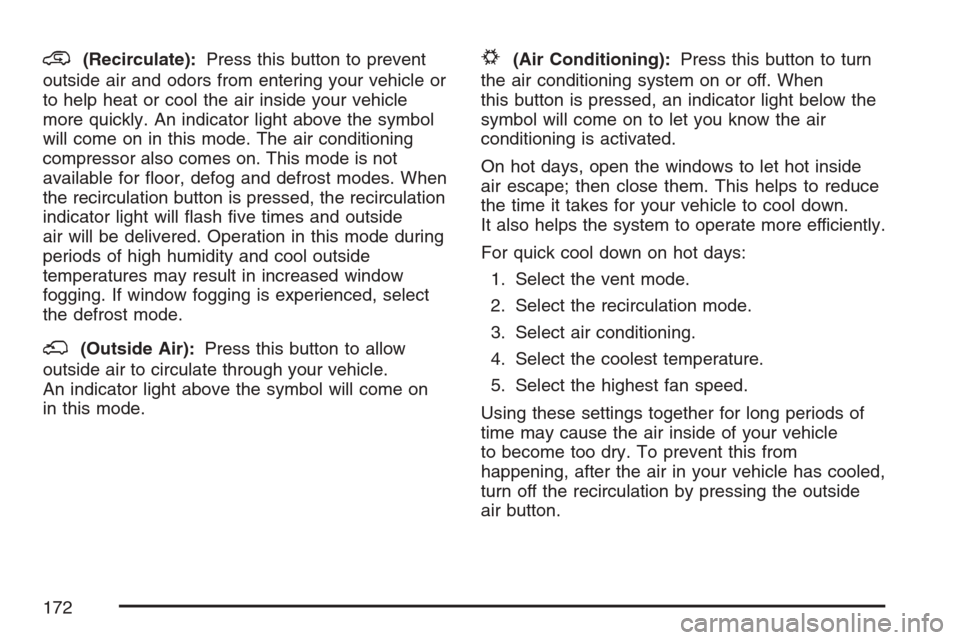
@(Recirculate):Press this button to prevent
outside air and odors from entering your vehicle or
to help heat or cool the air inside your vehicle
more quickly. An indicator light above the symbol
will come on in this mode. The air conditioning
compressor also comes on. This mode is not
available for �oor, defog and defrost modes. When
the recirculation button is pressed, the recirculation
indicator light will �ash �ve times and outside
air will be delivered. Operation in this mode during
periods of high humidity and cool outside
temperatures may result in increased window
fogging. If window fogging is experienced, select
the defrost mode.
;(Outside Air):Press this button to allow
outside air to circulate through your vehicle.
An indicator light above the symbol will come on
in this mode.
#(Air Conditioning):Press this button to turn
the air conditioning system on or off. When
this button is pressed, an indicator light below the
symbol will come on to let you know the air
conditioning is activated.
On hot days, open the windows to let hot inside
air escape; then close them. This helps to reduce
the time it takes for your vehicle to cool down.
It also helps the system to operate more efficiently.
For quick cool down on hot days:
1. Select the vent mode.
2. Select the recirculation mode.
3. Select air conditioning.
4. Select the coolest temperature.
5. Select the highest fan speed.
Using these settings together for long periods of
time may cause the air inside of your vehicle
to become too dry. To prevent this from
happening, after the air in your vehicle has cooled,
turn off the recirculation by pressing the outside
air button.
172
Page 173 of 446
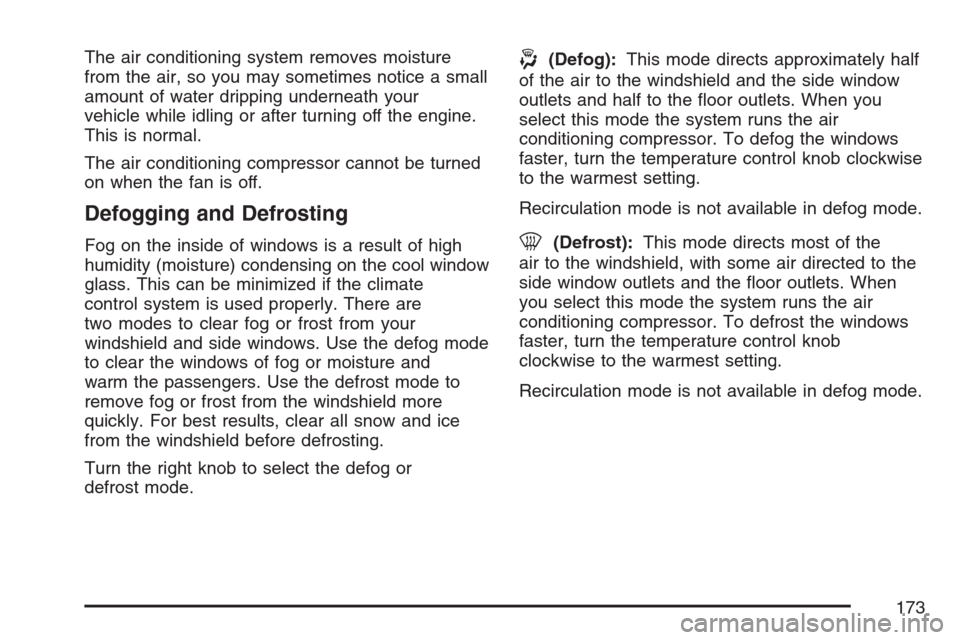
The air conditioning system removes moisture
from the air, so you may sometimes notice a small
amount of water dripping underneath your
vehicle while idling or after turning off the engine.
This is normal.
The air conditioning compressor cannot be turned
on when the fan is off.
Defogging and Defrosting
Fog on the inside of windows is a result of high
humidity (moisture) condensing on the cool window
glass. This can be minimized if the climate
control system is used properly. There are
two modes to clear fog or frost from your
windshield and side windows. Use the defog mode
to clear the windows of fog or moisture and
warm the passengers. Use the defrost mode to
remove fog or frost from the windshield more
quickly. For best results, clear all snow and ice
from the windshield before defrosting.
Turn the right knob to select the defog or
defrost mode.
-(Defog):This mode directs approximately half
of the air to the windshield and the side window
outlets and half to the �oor outlets. When you
select this mode the system runs the air
conditioning compressor. To defog the windows
faster, turn the temperature control knob clockwise
to the warmest setting.
Recirculation mode is not available in defog mode.
0(Defrost):This mode directs most of the
air to the windshield, with some air directed to the
side window outlets and the �oor outlets. When
you select this mode the system runs the air
conditioning compressor. To defrost the windows
faster, turn the temperature control knob
clockwise to the warmest setting.
Recirculation mode is not available in defog mode.
173
Page 285 of 446
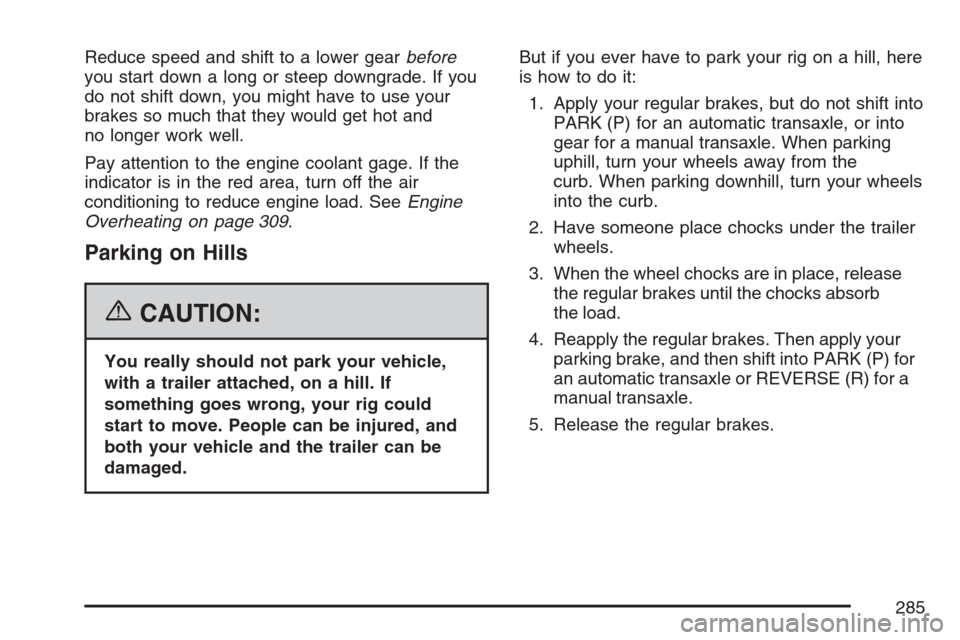
Reduce speed and shift to a lower gearbefore
you start down a long or steep downgrade. If you
do not shift down, you might have to use your
brakes so much that they would get hot and
no longer work well.
Pay attention to the engine coolant gage. If the
indicator is in the red area, turn off the air
conditioning to reduce engine load. SeeEngine
Overheating on page 309.
Parking on Hills
{CAUTION:
You really should not park your vehicle,
with a trailer attached, on a hill. If
something goes wrong, your rig could
start to move. People can be injured, and
both your vehicle and the trailer can be
damaged.But if you ever have to park your rig on a hill, here
is how to do it:
1. Apply your regular brakes, but do not shift into
PARK (P) for an automatic transaxle, or into
gear for a manual transaxle. When parking
uphill, turn your wheels away from the
curb. When parking downhill, turn your wheels
into the curb.
2. Have someone place chocks under the trailer
wheels.
3. When the wheel chocks are in place, release
the regular brakes until the chocks absorb
the load.
4. Reapply the regular brakes. Then apply your
parking brake, and then shift into PARK (P) for
an automatic transaxle or REVERSE (R) for a
manual transaxle.
5. Release the regular brakes.
285
Page 340 of 446
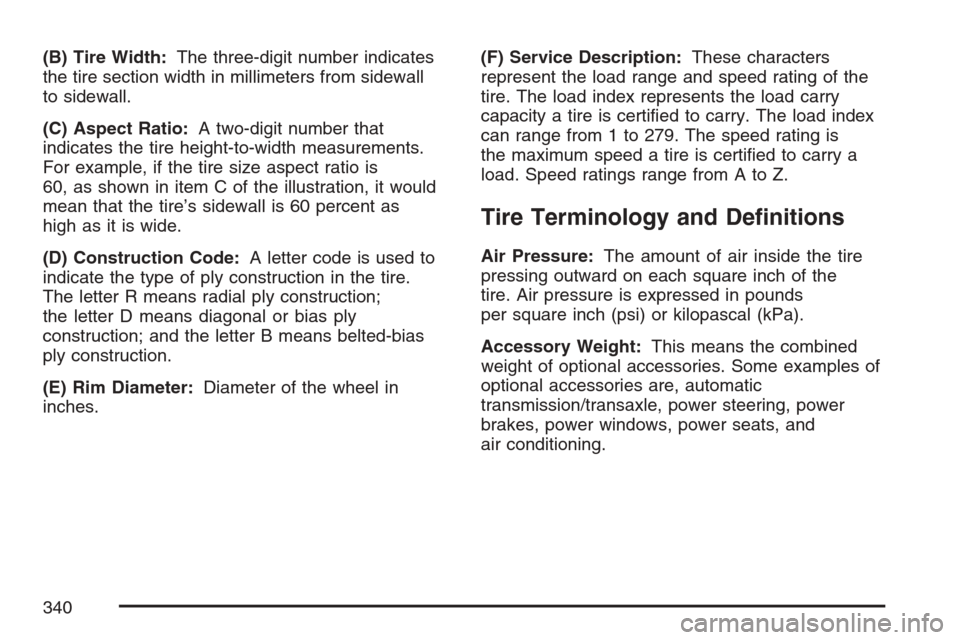
(B) Tire Width:The three-digit number indicates
the tire section width in millimeters from sidewall
to sidewall.
(C) Aspect Ratio:A two-digit number that
indicates the tire height-to-width measurements.
For example, if the tire size aspect ratio is
60, as shown in item C of the illustration, it would
mean that the tire’s sidewall is 60 percent as
high as it is wide.
(D) Construction Code:A letter code is used to
indicate the type of ply construction in the tire.
The letter R means radial ply construction;
the letter D means diagonal or bias ply
construction; and the letter B means belted-bias
ply construction.
(E) Rim Diameter:Diameter of the wheel in
inches.(F) Service Description:These characters
represent the load range and speed rating of the
tire. The load index represents the load carry
capacity a tire is certi�ed to carry. The load index
can range from 1 to 279. The speed rating is
the maximum speed a tire is certi�ed to carry a
load. Speed ratings range from A to Z.
Tire Terminology and De�nitions
Air Pressure:The amount of air inside the tire
pressing outward on each square inch of the
tire. Air pressure is expressed in pounds
per square inch (psi) or kilopascal (kPa).
Accessory Weight:This means the combined
weight of optional accessories. Some examples of
optional accessories are, automatic
transmission/transaxle, power steering, power
brakes, power windows, power seats, and
air conditioning.
340
Page 382 of 446
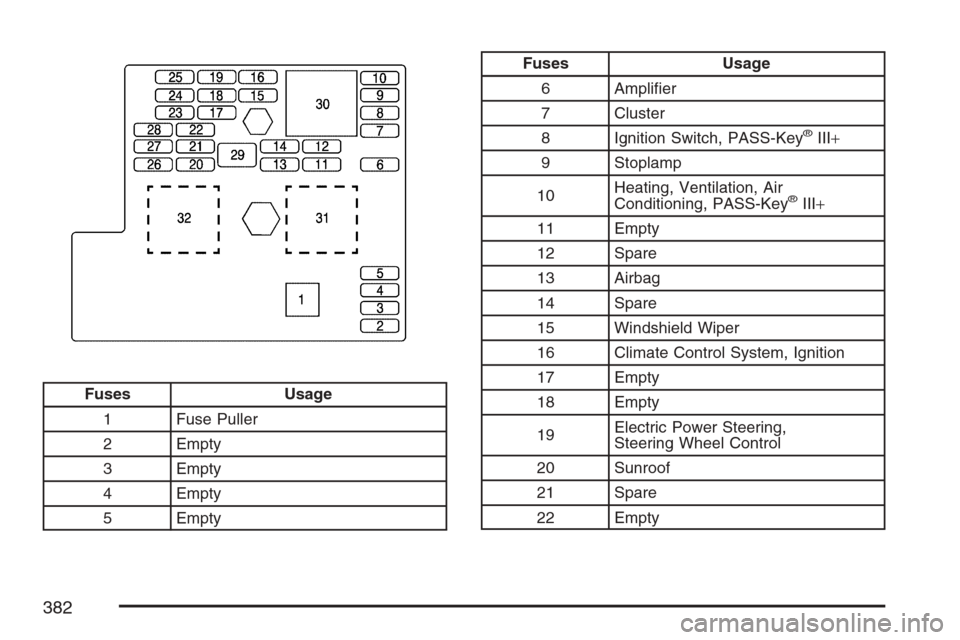
Fuses Usage
1 Fuse Puller
2 Empty
3 Empty
4 Empty
5 Empty
Fuses Usage
6 Ampli�er
7 Cluster
8 Ignition Switch, PASS-Key
®III+
9 Stoplamp
10Heating, Ventilation, Air
Conditioning, PASS-Key
®III+
11 Empty
12 Spare
13 Airbag
14 Spare
15 Windshield Wiper
16 Climate Control System, Ignition
17 Empty
18 Empty
19Electric Power Steering,
Steering Wheel Control
20 Sunroof
21 Spare
22 Empty
382
Page 384 of 446
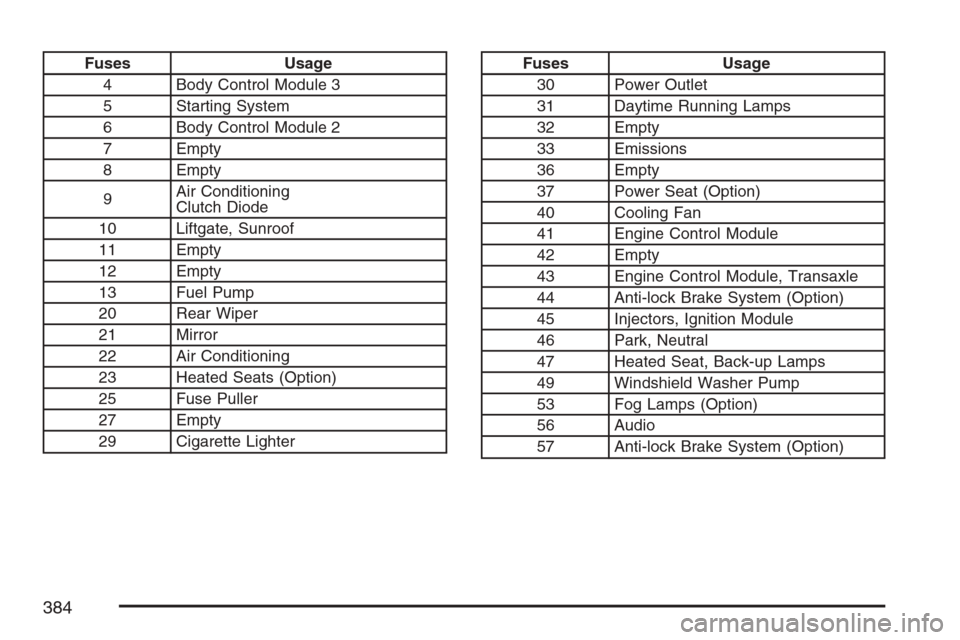
Fuses Usage
4 Body Control Module 3
5 Starting System
6 Body Control Module 2
7 Empty
8 Empty
9Air Conditioning
Clutch Diode
10 Liftgate, Sunroof
11 Empty
12 Empty
13 Fuel Pump
20 Rear Wiper
21 Mirror
22 Air Conditioning
23 Heated Seats (Option)
25 Fuse Puller
27 Empty
29 Cigarette LighterFuses Usage
30 Power Outlet
31 Daytime Running Lamps
32 Empty
33 Emissions
36 Empty
37 Power Seat (Option)
40 Cooling Fan
41 Engine Control Module
42 Empty
43 Engine Control Module, Transaxle
44 Anti-lock Brake System (Option)
45 Injectors, Ignition Module
46 Park, Neutral
47 Heated Seat, Back-up Lamps
49 Windshield Washer Pump
53 Fog Lamps (Option)
56 Audio
57 Anti-lock Brake System (Option)
384
Page 385 of 446
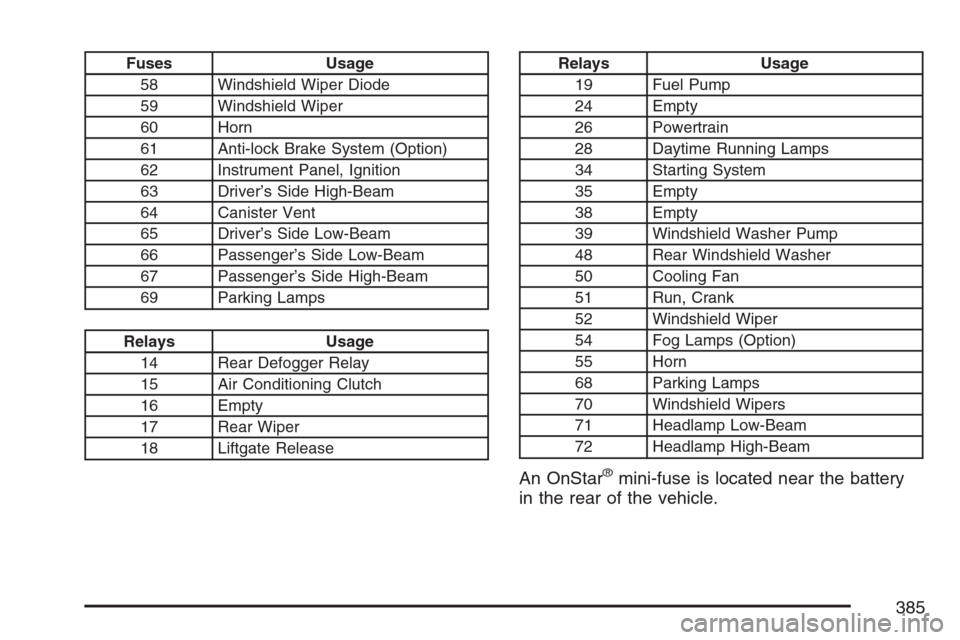
Fuses Usage
58 Windshield Wiper Diode
59 Windshield Wiper
60 Horn
61 Anti-lock Brake System (Option)
62 Instrument Panel, Ignition
63 Driver’s Side High-Beam
64 Canister Vent
65 Driver’s Side Low-Beam
66 Passenger’s Side Low-Beam
67 Passenger’s Side High-Beam
69 Parking Lamps
Relays Usage
14 Rear Defogger Relay
15 Air Conditioning Clutch
16 Empty
17 Rear Wiper
18 Liftgate Release
Relays Usage
19 Fuel Pump
24 Empty
26 Powertrain
28 Daytime Running Lamps
34 Starting System
35 Empty
38 Empty
39 Windshield Washer Pump
48 Rear Windshield Washer
50 Cooling Fan
51 Run, Crank
52 Windshield Wiper
54 Fog Lamps (Option)
55 Horn
68 Parking Lamps
70 Windshield Wipers
71 Headlamp Low-Beam
72 Headlamp High-Beam
An OnStar®mini-fuse is located near the battery
in the rear of the vehicle.
385
Page 386 of 446
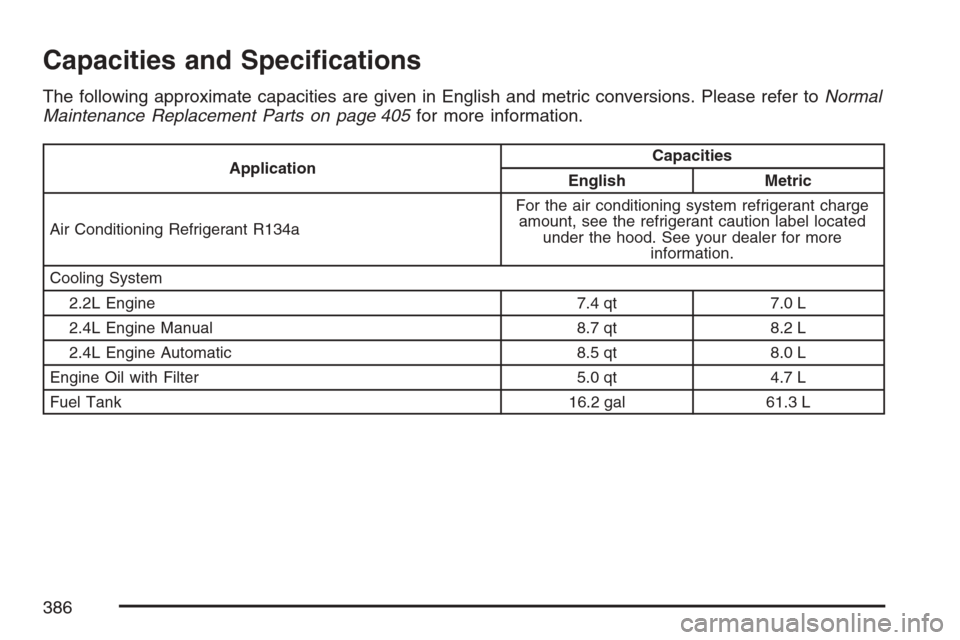
Capacities and Speci�cations
The following approximate capacities are given in English and metric conversions. Please refer toNormal
Maintenance Replacement Parts on page 405for more information.
ApplicationCapacities
English Metric
Air Conditioning Refrigerant R134aFor the air conditioning system refrigerant charge
amount, see the refrigerant caution label located
under the hood. See your dealer for more
information.
Cooling System
2.2L Engine 7.4 qt 7.0 L
2.4L Engine Manual 8.7 qt 8.2 L
2.4L Engine Automatic 8.5 qt 8.0 L
Engine Oil with Filter 5.0 qt 4.7 L
Fuel Tank 16.2 gal 61.3 L
386